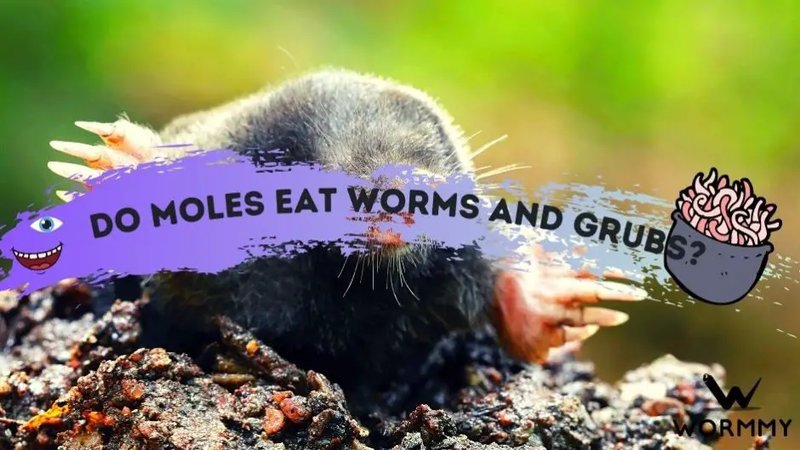
In this article, we’ll dive into the world of moles and grub worms. You might be surprised at how these two critters interact and what it can mean for your garden. And if you happen to have a lawn that seems to be a banquet for moles, stick around—we’ll also explore tips for managing these little diggers and their main course, the grub worms.
What Are Moles?
Moles are small, burrowing mammals that spend most of their lives below ground. They have velvety fur, spade-like hands, and tiny eyes. You can think of moles as nature’s little landscapers. While they might seem destructive—creating tunnels and pushing soil to the surface—they actually play a crucial role in aerating the soil. This helps improve drainage and promotes healthy grass growth.
Moles are mostly found in moist, sandy soil, where they can dig easily. One of their favorite snacks? You guessed it—grub worms! Moles rely on their keen sense of smell to locate these underground treats, digging down to feast on them whenever they can. This constant search for food leads to the distinctive molehills we often see in our yards.
What Are Grub Worms?
Grub worms are the larvae of various beetles, and they’re often found munching their way through roots in lawns and gardens. With a white, C-shaped body and a brown head, they might not look like much, but they can cause significant damage to your plants. Grubs usually feed on grass roots, leading to brown patches and, ultimately, the death of your grass if left unchecked.
These unwelcome guests thrive during warm months and can be especially damaging in late summer and fall when they’re at their largest. If you notice a lot of moles in your yard, it’s a sign that grub worms are plentiful. After all, moles have a built-in radar for finding these tasty treats, which leads to their constant tunneling and foraging behavior.
How Moles Detect Grub Worms
You might be wondering, “How do moles know where to dig?” Moles use their incredible sense of smell to sniff out grub worms underground. It’s pretty fascinating! They have specialized receptors in their snouts that allow them to detect the scent of grubs even if they’re buried deep beneath the soil.
Once a mole catches a whiff of their meal, they spring into action. They dig fast and furiously, using their powerful front limbs to burrow down. This is why you might notice moles creating extensive tunnel networks in your yard. They’re essentially establishing a food highway to snack on all those yummy grubs.
The Impact of Moles on Your Lawn
While moles can be beneficial for soil health, their presence often raises alarms for homeowners. If you’ve got a healthy population of moles in your garden, you might also notice the aftermath of their digging. Molehills can be unsightly, and the surface disruptions they cause can make your lawn uneven and bumpy.
On the flip side, a few moles can actually be a sign of a healthy ecosystem, as they’re keeping grub populations in check. Just like a balanced diet is essential for good health, a balance of critters can help keep your lawn thriving. If your grass is turning brown and patchy, it could mean you have too many grubs—drawing in those pesky moles to your yard.
How to Manage Moles and Grub Worms
If you find moles invading your yard, you don’t have to call in the exterminators just yet. There are several natural ways to manage both moles and their grub worm food sources. Here are a few strategies:
- Improve Soil Health: Healthy soil is less attractive to grubs. You can improve your soil health by aerating it and adding organic matter.
- Use Grub Control: There are many eco-friendly grub control products available that target grubs while being safe for other wildlife.
- Deter Moles: Planting herbs like marigolds or using natural repellents can help keep moles at bay without harming them.
Each of these steps helps create a strong lawn ecosystem where grubs are kept in check, making your yard less appealing to moles. Remember, balance is key—moles and grubs both play a part in the natural world, so finding a way to coexist can be beneficial.
When to Call in Professionals
Sometimes, no matter how much we want to manage the situation ourselves, it might be time to call in the professionals. If you’re dealing with a massive mole infestation or if grubs have completely taken over your yard, a pest control expert can provide solutions that are both effective and safe.
They can assess the situation and help you find a long-term solution, whether it’s trapping moles or treating for grubs. After all, it’s always better to address the root of the problem rather than just covering up the symptoms.
The Bottom Line
Understanding the connection between moles and grub worms can give you valuable insights into managing your yard. Yes, moles can create a mess, but they usually indicate a healthy population of grubs. By keeping an eye on both critters, you can better care for your lawn.
Armed with this knowledge, you can take steps to achieve a balanced ecosystem where both moles and grubs can thrive—at least to a manageable extent! So, the next time you see a mole popping up in your garden, remember that it’s all part of the intricate dance of nature. Just like any good relationship, it takes a little understanding and management to make it work.

